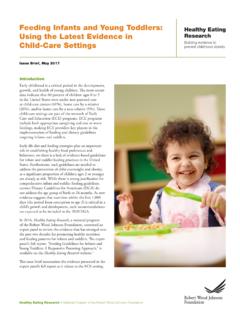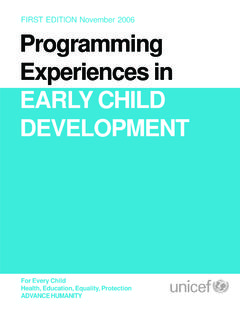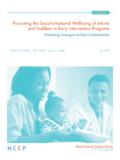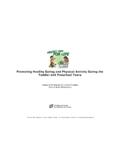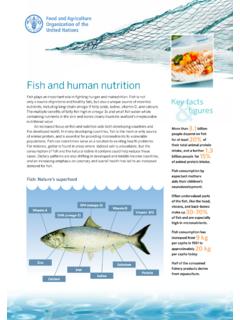Transcription of Strategic Direction for Child Maltreatment Prevention
1 Preventing Child Maltreatment Through the Promotion of Safe, Stable, and Nurturing Relationships Between Children and Caregivers Strategic Direction for Child Maltreatment Prevention This document describes a five-year vision for the Centers for Disease Control and Prevention s (CDC) work in Child Maltreatment (CM) Prevention . The overall strategy in preventing CM is to promote safe, stable, and nurturing relationships (SSNRs) between children and their caregivers. Background CM is a serious problem in the United States and around the , 2 It can be defined as any act or series of acts of commission or omission by a parent or caregiver that results in harm, potential for harm, or threat of harm to a Acts of commission are deliberate and intentional, however, harm to a Child may or may not be the intended consequence. Physical, sexual, and psychological abuse involve acts of commission.
2 Acts of omission involve failing to provide for a Child s basic physical, emotional, or educational needs or to protect them from harm or potential harm. Physical, emotional, medical/dental, and educational neglect; inadequate supervision or failure to supervise; and failure to protect from unsafe and violent environments when able, may all involve acts of omission. The magnitude of CM in the United States is not easily determined, but it is clearly substantial. According to state Child Protective Service (CPS) agencies, about 900,000 children are confirmed as having been maltreated each year in the United In these CPS cases, children under age three are at greatest risk and the majority of cases involve neglect. These confirmed cases of CM, however, represent only a fraction of the true magnitude of the problem because most cases are never reported to social service agencies or the 7 Survey data provide a more troublesome picture of this problem.
3 Based on a nationally representative survey of 2 17 year-olds, about 1 in 8 children were estimated to have been maltreated by physical, sexual, or psychological abuse or neglect from 2002 to Surveys of adults reveal that self-reported histories of CM is relatively common. In a national survey, of men and of women reported histories of sexual abuse and of men and of women reported histories of physical Substantial documentation exists in scientific literature of the association between CM and a broad range of emotional, behavioral, and physical health problems. These consequences may vary depending on a Child s age when victimized, duration and severity of the abuse or neglect, the Child s innate resiliency, and co-occurrence with other Maltreatment or adverse exposures such as the mental health of the parents, substance abuse by the parents, or violence between , 11 Aggression, conduct disorder, delinquency, anti social behavior, substance abuse, intimate partner violence, teenage pregnancy, post traumatic stress disorder, anxiety, depression, and suicide are among the emotional and behavioral problems associated with 15 Maltreatment and other adverse exposures also have been associated with poor adult health status; specific health problems such as diabetes, ischemic heart disease, and sexually transmitted diseases.
4 And a variety of health risk behaviors including smoking and 19 In addition, exposure to CM can have negative repercussions for cognitive development, including language deficits and reduced cognitive One mechanism for these consequences is the harmful impact that chronic or recurrent exposure to stress, such as that caused by CM, can have on the inter-related brain circuits and hormonal systems that regulate stress ( , sympathetic-adrenomedullary system, hypothalamic-pituitary-adrenocortical system).21 23 These brain systems are particularly malleable during early childhood, a time of heightened risk for severe Changes in these brain systems can lead to a premature physiological aging of the body that increases vulnerability to mental and physical health 23 CDC s Mission and Niche in Violence Prevention CDC s CM Prevention program is coordinated by the Division of Violence Prevention (DVP) within the National Center for Injury Prevention and Control (NCIPC).
5 DVP s mission is to prevent violence-related injuries and deaths through surveillance, research and development, capacity building and adoption, communication, and leadership. DVP s public health approach to violence Prevention complements other approaches such as those of the criminal justice, mental health, and Child welfare systems. Its unique features and niche include: An emphasis on primary Prevention of violence perpetration. DVP emphasizes efforts to prevent CDC s Approach to violence before it occurs. This requires not only Violence Prevention reducing the factors that put people at risk but also increasing the factors that protect people from An emphasis on primary Prevention becoming perpetrators of violence. of violence perpetration A commitment to a rigorous science base. DVP A commitment to a rigorous science adds to the base of what is known about violence base and how to prevent it by monitoring and tracking A cross-cutting perspective trends using public health surveillance and other A population approach strategies, researching risk and protective factors, and rigorously evaluating interventions and learning how best to implement and disseminate them.
6 A cross-cutting perspective. Public health encompasses many disciplines and perspectives, making its approach well-suited for examining and addressing multifaceted problems like vio lence. Different sectors such as health, media, business, criminal justice, behavioral science, epidemiology, social science, advocacy, and education all have important roles in violence preven tion. Different forms of violence are interrelated. For example, exposure to CM is associated with interpersonal violence and suicidal behavior in adolescence and 25 Moreover, just as different forms of violence are related to each other, violence is also associated with and a risk factor for many other health problems. 2 A population approach. Part of public health s broad view is an emphasis on population health not just the health of individuals. Individuals experience violence acutely, but its conse quences and potential solutions also affect society in general.
7 The long-term goal of public health is to achieve lasting change in the factors and conditions that place people at risk by making changes at the individual, family, community, and societal levels of the social ecology that reduce rates of violence in populations. Rationale for Promoting Safe, Stable, and Nurturing Relationships between Children and Caregivers Safe, stable, and nurturing relationships (SSNR) between children and their caregivers are the antithesis of Maltreatment and other adverse exposures that occur during childhood and compromise health over the lifespan. Young children experience their world through their relationships with parents and These relationships are fundamental to the healthy development of the brain and, consequently, the development of physical, emotional, social, behavioral, and intellectual 27 From a public health perspective, the promotion of SSNRs is, therefore, Strategic in that, if done successfully, it can have synergistic effects on a broad range of health problems as well as contribute to the development of skills that will enhance the acquisition of healthy habits and lifestyles.
8 The three dimensions of SSNRs ( , safety, stability, and nurture) each represent important aspects of the social and physical environments that protect children and promote their optimal development. Each can be thought of as being on the positive end of a continuum that extends from safe to neglectful and violent relationships/environments, from stable to unpredictable and chaotic relationships/ environments, and from nurturing to hostile/cold or rejecting relationships/environments. These dimensions overlap, but each represents important and distinct aspects of a Child s relationships and environment that are crucial to their healthy development. These dimensions can be more fully defined and described in the following ways: Safety. Safety refers to the extent to which a Child is free from fear and secure from physical or psychological harm within their social and physical environment.
9 Childhood exposure to physical, sexual, or psychological violence is a direct threat to a Child s safety. Neglect or acts of omission affect safety as well. For example, failure to properly secure a Child in a car seat or ensure that poisons are stored securely in the home are clear threats to safety. Caregivers ensure the safety of children by regulating their emotional response to their children; protecting children under their care from others that may harm them; disciplining their children in ways that do not cause harm and promote self regulation; monitoring their Child s behavior and development; and ensuring the Child s environment is hazard 28 The nature of these vital functions for parents and caregivers change as a Child matures, but remain important through adolescence. The security of a Child s broader social environment, which includes the magnitude of crime in a neighborhood and the presence of social supports within a community, is also an important aspect of this dimension.
10 Stability. Stability refers to the degree of predictability and consistency in a Child s environment. It encompasses consistency in who children relate to as well as the nature of their interactions with caregivers, others in their environment, and the environment itself. A Child s interaction with their environment is important for determining their working model of how the world works, what to expect, and how to interact appropriately with those around them. Stability is critical to providing the Child with a sense of coherence, , seeing the world as predictable and 30 Family structures and 3 routines that provide stability buffer the impact of stressful experiences on Disruptions in the stability of a Child s relationships or environment, whether by divorce, death, or frequently changing caregivers, may deprive a Child of the secure and nurturing attachments needed for optimal Moreover, the lack of stable relationships or environments may also increase the likelihood that a Child will be exposed to relationships and environments that are stressful and Instability in the lives of parents as reflected by divorce, separation.











